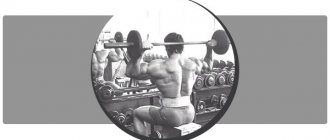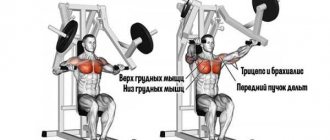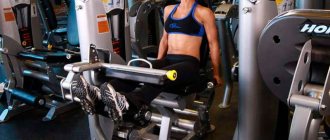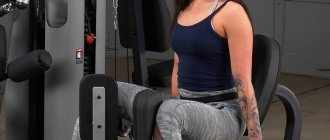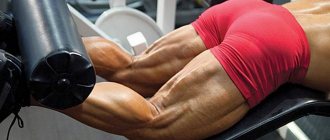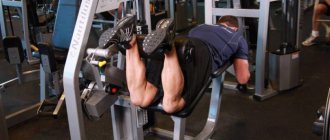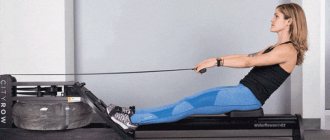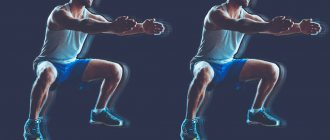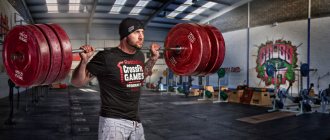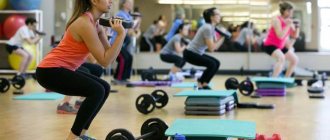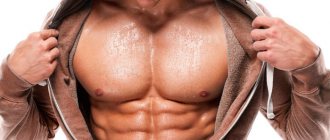Published:
29.11.2017
The Smith machine seated press is a type of vertical press performed in a machine and is aimed at adding volume and shape to the muscles of the shoulder girdle.
By and large, Smith presses imitate movement with free weights, but the machine version of the work is considered more “concentrated.” Due to the fact that the bar moves along guides and has a fixed trajectory, most of the stabilizing muscles are turned off, and the main load falls on the target muscles.
What muscles does the shoulder press work?
As mentioned earlier, the main working muscles when performing shoulder presses in the simulator will be:
- Deltoid.
These muscles are responsible for shoulder extension (raising the arm up). Depending on the execution option, the load will change slightly, moving from the middle delta to the front and vice versa. As for the posterior head, in this exercise it will perform more of a stabilizing function. - Triceps.
When it comes to pressing exercises, the triceps cannot be left out. This muscle is activated to its maximum in the final phase of movement, at the moment of extension of the arm at the elbow joint. In order to reduce the load on it, it is recommended to work within the amplitude. That is, in the final phase of the exercise, the arms remain slightly bent. - Breasts.
In particular, the upper (clavicular part). Since the angle of the bench is almost 90°, the chest will be used minimally. But if we lower the backrest lower, the load on them will increase.
In addition to the main muscles, auxiliary muscles will work. These include:
- Diamond-shaped
- Trapezoid
- Serratus anterior muscles
They will act as stabilizers for the scapula and are also responsible for its movement.
Theory
Shoulders are one of the few muscle groups that cannot be fully developed in one movement. Any exercise on the deltoid muscle primarily uses only one bundle. As you know, the deltoid muscle consists of three bundles, which, although connected at the bottom by one tendon, like the triceps, however, unlike the latter, they are not located in the same plane with each other, but on different sides of the shoulder: in front, side and back. Just like the fibers of the pectoral muscle, they are maximally involved in the load only when the direction of their contraction coincides with the direction of movement of the humerus. For this reason, for the full development of the shoulder, at least three exercises are needed, providing different angles of movement of the projectile. The only exercise that more or less involves two deltoid bundles at once (front and side) is the overhead barbell press. At least this is shown by studies related to measuring the electrical activity of different areas of muscles using an electromyograph, and this is confirmed by practice. The posterior bundle in this exercise is also not relaxed, but the degree of load on it is unlikely to lead to any development. In addition, due to the structural features of the shoulder girdle, in some individuals the participation of the lateral head in the overhead press may be minimized.
Thus, isolated work on the rear and middle deltoids should be present in most practitioners. But as for the front beam, it should be taken into account that it receives maximum load with all types of vertical presses, as well as horizontal presses, on an incline bench and push-ups. In connection with this, most athletes who practice presses in training the shoulders and chest do not need to do isolating exercises on this part of the deltoid muscle; moreover, this can result in its overtraining. Therefore, a sufficient set of exercises for a bodybuilder includes: bench press of a barbell or dumbbells, swings (raises) of dumbbells to the sides and in an incline, or their variants in cable simulators, for example, in a crossover.
Benefits of this exercise
- When performing bench presses in a machine, stabilizer muscles are excluded from the movement. Therefore, most of the load goes to the deltas.
- By resting the body on the back, the risk of spinal injury is reduced.
- The machine allows you to work with heavy weights without fear of dropping it. You can lower the levers onto special stops at any time.
- This exercise helps strengthen the shoulder joints, which reduces the risk of injury.
- The development of the muscles of the shoulder girdle allows you to increase working weights in basic exercises. Starting from the BENCH PRESS and ending with the OVERHEAD BAR PRESS.
- If you follow the exercise technique and work in a strength mode, you can count on an increase in the volume of the deltoid muscles.
- A simple technique that can be easily mastered by athletes of any skill level.
- Possibility of shifting the emphasis from the front head to the middle one and vice versa. It is also possible to work with each arm separately, as when performing a SEATED DUMBBELL PRESS.
- Movement in the simulator occurs along the trajectory specified by it, which significantly reduces the risk of straining the shoulder muscles.
Leg press: features of the exercise
The leg press on the machine is an excellent replacement for squats with weights (barbell). But during squats, there is a possibility of damaging the knee joints, which is almost impossible on a special platform if you follow safety precautions.
The sports platform allows you to strengthen all muscle groups in the lower extremities, as well as develop the hip joints, which is important for the female body. There is one thing - but! You need to exercise carefully, and gradually increase the weight and number of repetitions.
In the first workouts, 15 lifts of 2 repetitions with a break of 30 seconds are enough to give the muscles time to rest.
There is one thing - but! You need to exercise carefully, and increase the weight and number of repetitions gradually. In the first workouts, 15 lifts of 2 repetitions with a break of 30 seconds are enough to give the muscles time to rest.
After 2 weeks, you can make the workout more difficult by increasing the number of repetitions. Of course, at the end of the session it will be difficult for you to make the last jerks, but the severity means that the muscles begin to fill and grow.
Benefit
The leg press exercise on a machine in bodybuilding is the best part of any workout, especially after squats with a barbell. The benefits of the exercise are due to the fact that it increases muscle mass and develops the pelvic organs.
By doing the leg press, your gluteal muscles, along with your quadriceps and hamstrings, receive a highly concentrated workout.
The advantage of the leg press is the absence of negative load on the spine. Simply put, this exercise can be done by everyone without restrictions, be it people with back problems, girls or those recovering from an illness or surgery.
While doing leg presses, blood circulation in the pelvic area improves, thereby stimulating the body's production of the hormone testosterone.
Important! It is necessary to adhere to the correct exercise technique
Injury hazard
When visiting the gym for the first time, you can easily injure yourself and forget about playing sports forever. Egocentrism should be left outside the gym, because you risk losing your health.
The leg press is one of the most dangerous exercises you can do in the gym.
Most athletes, overestimating their strength, put a huge weight of 400-500 kilograms on sports equipment, while forgetting about their capabilities. Such weight on the platform will not allow you to perform 3 lifts with normal amplitude. Soon, this approach to the exercise will lead to joint rupture, fracture or injury to the lower leg when doing the leg press.
The level of required weights in the first lessons should not exceed 50 kilograms. This will be enough to prepare the muscles for the next stage.
When doing leg presses, you need to gradually increase the weight of the bars and monitor your well-being. The back should always be straight. In addition, you should combine bench presses and squats with a barbell to enhance the effect of the exercise.
Remember! Sports should bring joy, not pain and injury.
Contraindicated for whom
Contraindications include health problems that occur both in athletes who have been injured and in ordinary people who have suffered a heavy load on the spine. Leg presses are contraindicated for people suffering from the following problems:
- Scoliosis of all stages, lordosis, kyphosis. People with these spinal diseases can perform leg press exercises, but under the supervision of a special instructor. Doctors recommend wearing an athletic belt, which will remove excess stress from the vertebrae.
- Diseases or congenital pathologies affecting the knee and ankle joints. If you do not listen to a fitness instructor or your doctor, you can get serious injuries to your knee joints or a ruptured ankle.
- You should not put a lot of stress on your back if you suffer from any disease of the spine or complain of lower back pain. Don’t “play” with weights on the machine and surrender to the will of the trainer, who will select the weight you need.
Important! Contraindications also affect women with diseases of the internal genital organs or during pregnancy
What muscles are involved?
With the help of a basic exercise, you can ideally pump up any muscle area of the lower limbs and hips. It should be understood that the narrower the position of the legs, the greater the load on the quadriceps.
Let's consider which muscles work on the simulator in addition to the quadriceps:
- femoral biceps;
- buttock muscles;
- knee;
- ankle
The one-leg press enhances the effect on the buttocks, which allows you to increase the load on a certain area.
Execution technique
Before we begin to consider the execution technique, we need to say a few words about the simulator itself. There are currently two varieties:
- Lever.
Or they are also called “hummers”. The weights in it are discs from the barbell, which are hung on special ledges. There are two types of lever exercise machines: with separate levers and with one solid one. The first simulates working with dumbbells, the second with a barbell. A bench is also welded to the simulator. Basically, the angle is already set at approximately 75-80°, but there are those where the backrest can be raised or lowered. The seat height is also adjustable. - Blocky.
Blocks are used as weights, which are attached to the levers using cables. The operating principle of this simulator is similar to the previous one. Just don’t carry weights from the barbell from side to side around the gym.
In addition, there is a simulator in which you can perform this bench press while standing. But it is extremely rare to find it, so the sitting option is considered classic. Using his example, we will analyze the execution technique.
Initial position:
- First of all, you need to adjust the seat height in the exercise machine to suit your post. We will be guided by the height of the handles. They should be at the level of the collarbones.
- After this, we set the required weight by hanging pancakes or installing the required number of blocks.
- We sit in the simulator. We press our head, shoulder blades and pelvis against the backrest. Legs are spread apart, feet rest on the floor.
- We grab the handles with a wide grip, palms facing forward.
- Shoulders and shoulder blades are down. The elbows are brought forward and are located in line with the hand.
- We push our chest forward a little and slightly arch our lower back. We statically tense our abdominal muscles.
Performance:
- As you exhale, we extend our arms at the shoulder and elbow joints, performing an upward press.
- Next, slowly and under control, lower the handles of the simulator down and exhale.
Tags
Legs for legs Legs for legs for legs one leg water leg water leg water leg pump up your buttocks.pump up your buttocks. Exercises Exercises Exercises in Exercises for performing the exercise. these exercises we Exercise refers to Performing the exercise bench press exercises the average given exercise in view of the squat as an alternative to the squat. squats withPerforming squats with Sumo squats
weight losssquatworkoutsbetter jointnutritioninitialprogramsarmspressfitnessdietcommenthealthno
Recommendations for implementation
- When the handles are in the upper position, your arms should remain slightly bent. We already talked about this when we looked at working muscles.
- There is no need to artificially increase the range of motion by lowering the handles of the machine. This will not help in the development of deltas, but it can cause injuries to the shoulder joint.
- When returning to the starting position, the elbows should not go back. This will cause the humerus to externally rotate, putting it at risk of impinging on the acromion of the scapula. As a result, the supraspinatus muscle may be injured.
- The back should be pressed against the bench to avoid excess load on the spinal column.
- The return to the starting position must be controlled. There is no need to suddenly relax your hands and throw down the levers of the simulator. This can cause injury to the shoulder and rotator cuff muscles.
- Do not twist your hands while doing the press. This technique can cause injury to the wrist joint.
- Choose the right working weight. Although the machine is safer than working with free weights, the emphasis should still be placed on execution technique.
What mistakes should you avoid when performing leg presses?
To achieve maximum effect and avoid injury, avoid the following mistakes:
- Selecting the wrong range . The quadriceps receive maximum load when the knees are bent at an angle of 90–100°. Moving at the top of the range, you put emphasis on the back of the thigh, which is not entirely justified, since there are much more effective exercises for pumping it up.
- Incorrect knee position . Make sure they look forward or slightly to the sides, do not bring them together.
- Separation of the lower back or pelvis from the chair . By rounding or arching your back, you place unnecessary stress on your lower back.
- Locking the knees at the top . By fully straightening your legs at the joint, you remove stress from the muscles and risk reducing progress.
Press options in the simulator
If you want to diversify your training a little, you can try some variations of the bench press in the simulator.
Press with a narrow (parallel) grip
Some machines are equipped with two types of handles. The first one is located widely, as in the classic version. Second, narrow. We will grab these handles with a parallel grip (palms facing each other). Due to this, the elbows will come out a little forward and the load will shift to the front heads. Otherwise, the execution technique is the same as the classic version.
Facing press machines
To perform this option, we will need to sit facing the machine and rest our forehead against the back of the bench. Thanks to this arrangement, we will be forced to move our elbows back. Thanks to this, we will load the middle head of the deltoid muscles more. It is worth considering that this option should be started only after mastering the classic one. Since pressing your face to the machine, with insufficient flexibility of the shoulder joint, can do more harm than good. Causing a shoulder injury.
Alternate press
Executing this option will allow you to work on each delta separately. It is recommended only for those athletes who have obvious asymmetry in shoulder development. In this case, we can choose any of the above options and combine it with alternate execution.
Standing press in the simulator
But this version of the bench press can be found extremely rarely. The problem is that not all gyms have such a simulator. But who knows, maybe in the near future they will begin to be purchased en masse and you and I will be able to test the standing press for effectiveness. The principle of implementation is quite simple. We hang the pancakes on the levers. We stand facing the simulator. Keep your back straight, feet shoulder-width apart. As you exhale, press the handles up, and as you inhale, lower them down. You can perform this option in the SWING style. That is, at the moment of the press, we slightly bend our legs at the knee joints and push the levers up onto straight arms. This style of execution will allow you to work with much more weight.
Photo mistakes: if your legs hurt after a workout
What are you doing wrong if you experience leg pain after doing leg presses? How to do the exercise correctly (here is an article on recovery ):
- Push press (i.e. you lower the platform down quickly and haphazardly in the style of “just lower it, otherwise I’ll die”).
- Separation of the pelvis from the back. The platform must be lowered to such a level (as you feel, the guideline is 90 degrees) so that the lower back is glued to the back of the machine, otherwise the tube will be injured. Therefore, you need to lower the platform until you feel that you are doing a “safe” bench depth.
We found this option on the Internet and want to say: don’t do this, it’s just super dangerous, traumatic and pointless, such tricks can be replaced with banal gluteal swings, don’t take risks like that!A safe depth is when your lower back is pressed tightly against the back of the seat. With excessive “heroism”, the depth becomes unsafe, i.e. you lower the platform with your legs to such a depth that your lower back is already coming off.
Tips for maximum efficiency
- Before performing bench presses in the simulator, you must complete a set of WARM-UP EXERCISES. Particular attention should be paid to the shoulder and elbow joints
- First, you should focus on working out the execution technique. After you bring it to ideal, you can start building up working weights.
- The bench press can be performed as a main exercise. To do this, it is recommended to work on 8-10 repetitions in 3-4 approaches.
- You can also leave this bench press a finishing role at the end of the workout. To do this, we reduce the working weight and work in a multi-repetition mode. Approximately 3-4 sets of 12-15 repetitions.
The machine press is a good exercise that allows you to develop the deltoid muscles. It is suitable for athletes of any level of training. The main thing is to monitor the technique and correctly select the working weight, which should gradually increase.
Good luck to everyone in your training!
